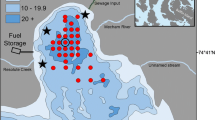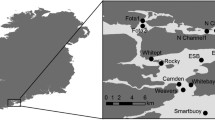Abstract
Atlantic cod stocks are subdivided into geographically and biologically discrete populations; some being locally resident, others migratory. The reasons for the variation in migration pattern and the consequences it may have for population structuring is poorly understood. We studied a group of cod from the coastal waters of the Shetland Isles in the northern North Sea. During the spawning season, electronic tags that record depth and temperature over time were implanted into 133 individuals and the fish released within a few kilometres of where they were captured. Thirty-nine cod have been recaptured up to 608 days later, throughout the year and, in all but two cases, within 15 km of their release site. Geolocation methods based on temperature and bathymetry also suggested that the cod had a limited home range, remaining resident year-round in coastal waters. The cod were deeper during the winter and moved to shallower water in late spring and summer. They showed diel, fortnightly and monthly cycles in depth movement that varied much within and between individuals over the season. Residency and the individual variability in vertical movement may reflect a combination of locally complex depth strata, variable seabed substrate and the wide range of seasonally available prey resources.









Similar content being viewed by others
References
Alderstein SA, Welleman HC (2000) Diel variation of stomach contents of North Sea cod (Gadus morhua) during a 24-h fishing survey: an analysis using generalised additive models. Can J Fish Aquat Sci 57:2363–2367
Arnold GP, Dewar H (2001) Electronic tags in marine fisheries science: a 30 years perspective. In: Sibert J, Neilsen Dordrecht J (eds) Electronic tagging and tracking in marine fisheries. Kluwer Academic Press, Dordrecht, pp 7–64
Arnold GP, Greer-Walker M, Emerson LS, Holford BH (1994) Movements of cod (Gadus morhua L) in relation to tidal streams in the southern North Sea. ICES J Mar Sci 51:207–232
Cadrin SX, Friedland KD, Waldman JR (eds) (2004) Stock identification methods: Applications in fishery science. Elsevier, Amsterdam
Cleveland WS (1993) Visualizing data. ATandT Bell Laboratories, NJ
Comeau LA, Campana SE, Castonguay M (2003) Automated monitoring of a large-scale cod (Gadus morhua) migration in the open sea. Can J Fish Aquat Sci 59:1845–1850
Exadactylos A, Geffen AJ, Panagiotaki P, Thorpe JP (2003) Population structure of dover sole (Solea solea): RAPD and allozyme data indicate divergence in European stocks. Mar Ecol Prog Ser 246:253–264
Freeman S, Mackinson S, Flat R (2004) Diel periodicity in the habitat utilisation of sandeels revealed using integrated acoustic surveys. J Exp Mar Biol Ecol 305:141–154
Godø OR, Michalsen K (2000) Migratory behaviour of north-east Arctic cod studied by use of data storage tags. Fish Res 48:127–140
Green JM, Wroblewski JS (2000) Movement patterns of Atlantic cod in Gilbert Bay, Labrador: evidence for bay residence and spawning site fidelity. J Mar Biol Ass UK 80:1077–1085
Grewe PM, Elliot NG, Innes BH, Ward RD (1997) Genetic population structure of southern bluefin tuna (Tunnus maccoyii). Mar Biol 127:555–561
Hedger RE, McKenzie E, Heath M, Wright PJ, Scott B, Gallego A, Andrews J (2004) Analysis of the spatial distributions of mature cod (Gadus morhua) and haddock (Melanogrammus aeglefinus) abundance in the North Sea (1980–1999) using general additive modelling. Fish Res 70:17–25
Heffernan O, Righton D, Michalsen K (2004) Use of data storage tags to quantify vertical movements of cod: effects on acoustic measures. ICES J Mar Sci 61:1062–1070
Hunter E, Aldridge JN, Metcalfe JD, Arnold GP (2003) Geolocation of free-ranging fish on the European continental shelf as determined from environmental variables I Tidal location method. Mar Biol 142:601–609
Hutchinson WF, Carvalho GR, Rogers SI (2001) Marked genetic structuring in localised spawning populations of cod Gadus morhua in the North Sea and adjoining waters as revealed by microsatellites. Mar Ecol Prog Ser 223:251–260
Imsland AK, Jonsdottir ODB (2003) Linking population genetics and growth properties of Atlantic cod. Rev Fish Biol Fish 13:1–26
Iles TD, Sinclair M (1982) Atlantic herring: Stock discreteness and abundance. Science 215:627–633
Iwamoto E, Ford MJ, Gustafson RG (2004) Genetic population structure of Pacific hake, Merluccius productus, in the Pacific Northwest. Environ Biol Fish 69:187–199
Jonsdottir ODB, Danielsdottir AK, Naevdal G (2001) Genetic differentiation among Atlantic cod (Gadus morhua L.) in Icelandic waters: temporal stability. ICES J Mar Sci 58:114–122
Knutsen H, Jorde PE, Andre C, Stenseth C (2003) Fine-scaled geographic population structuring in a highly mobile marine species: the Atlantic cod. Mol Ecol 12:385–394
Lawson GL, Rose GA (2000) Seasonal distribution and movements of coastal cod (Gadus morhua L.) in Placentia bay, Newfoundland. Fish Res 49:61–75
Linkowski TB (1996) Lunar rhythms of vertical migrations coded in the otolith microstructure of North Atlantic lantern fishes, genus Hygophum (Myctophidae). Mar Biol 124:495–508
Løkkeborg S, Ferno A (1999) Diel activity pattern and food search behaviour in cod, Gadus morhua. Environ Biol Fish 54:345–353
Metcalfe JD, Arnold GP (1997) Tracking fish with electronic tags. Nature 387:665–666
Metcalfe J, Arnold G, McDowall R (2002) Migration. In: Hart PJB, Reynolds JD (eds) Handbook of fish biology and fisheries. Blackwell Publishing, Oxford, pp 175–199
Morris CJ, Green JM (2002) Biological characteristics of a resident population of Atlantic cod (Gadus morhua L.) in Southern Labrador. ICES J Mar Sci 59:666–678
Nesbo CL, Rueness EK, Iversen SA, Skagen DW, Jakobsen SK (2000) Phylogeography and population history of Atlantic mackerel (Scomber scombrus L): a genealogical approach reveals genetic structuring among the eastern Atlantic stocks. Proc R Soc Lond B 267:281–292
Neuenfeldt S, Hinrichsen H, Neilsen A (2004) A method to geolocate eastern Baltic cod by using data storage tags (DSTs). ICES CM 2004/L:06 1–14
Newton A, Coull K, Peach K, Coggin R, Robb A, Blasdale T, Breen M, Burns F, Davis S, Bullough L (2002) Industry/science partnership 2001–2002, Vol 2: Report on biological information gathered from Scottish fishing vessels. FRS Marine Laboratory, Aberdeen
Olsen EM, Knutsen H, Gjosaeter J, Jorde PE, Knutsen JA, Stenseth NC (2004) Life-history variation among local populations of Atlantic cod from the Norwegian Skagerrak coast. J Fish Biol 64:1725–1730
Palsson OK, Thorsteinsson V (2003) Migration patterns, ambient temperature and growth of Icelandic cod (Gadus morhua): evidence from storage tag data. Can J Fish Aquat Sci 60:1409–1423
Rae BR (1967) The food of cod in the North Sea and on the West of Scotland grounds. Mar Res Series 1:1–68
Reebs SG (2002) Plasticity of diel and circadian rhythms in fishes. Rev Fish Biol Fish 12:349–371
Righton D, Metcalfe J, Connolly P (2001) Different behaviour of North and Irish sea cod. Nature 411:156
Robichaud D, Rose GA (2004) Migratory behaviour and range in the Atlantic cod: inference from a century of tagging. Fish Fish 5:185–214
Ruzzante D, Taggart CT, Cook D (1999) A review of the evidence for genetic structure of cod (Gadus morhua) in the Northwest Atlantic and population affinities of larval cod off Newfoundland and the Gulf of St Lawrence. Fish Res 43:79–97
Ruzzante DE, Wroblewski JS, Taggart CT, Smebdol RK, Cook D, Goddard SV (2000) Bay-scale population structure in coastal Atlantic cod in Labrador and Newfoundland, Canada. J Fish Biol 56:431–447
Ryman N, Utter F, Laikre L (1995) Protection of intraspecifc biodiversity of exploited fishes. Rev Fish Biol Fish 5:417–446
Salvanes AGV, Skjaeraasen JE, Nilsen T (2004) Sub-populations of coastal cod with different behaviour and life history strategies. Mar Ecol Prog Ser 267:241–251
Sinclair M (1988) Marine populations: An essay on population regulation and speciation. Washington Sea Grant Press, Seattle
Stensholt BK (2001) Cod migration patterns in relation to temperature: analysis of storage tag data. ICES J Mar Sci 58:770–793
Temming A, Gotz S, Mergardt N, Ehrich S (2004) Predation of whiting and haddock on sandeel: aggregative response, competition and diel periodicity. J Fish Biol 64:1351–1372
Vis ML, Carr SM, Bowering WR, Davidson WS (1997) Greenland halibut (Rheinhardtius hippoglossoides) in the North Atlantic are genetically homogeneous. Can J Fish Aquat Sci 54:1813–1821
Waples RS (1995) Evolutionary significant units and the conservation of biological diversity under the endangered species act. Am Fish Soc Symp 17:8–27
Wright PJ (1996) Is there a conflict between sandeel fisheries and seabirds? A case study at Shetland. In: Greenstreet SPR, Tasker ML (eds) Aquatic predators and their prey. Blackwell Science, Oxford, pp 154–165
Yoneda M, Wright PJ (2004) Temporal and spatial variation in reproductive investment of Atlantic cod Gadus morhua in the northern North Sea and Scottish West coast. Mar Ecol Prog Ser 276:237–248
Acknowledgements
We thank the skipper and crew of FRV ‘Clupea’ and the fishermen who have co-operated by returning tagged fish to us. We are grateful to G. Slesser for provision of the hydrographic data, K. Mutch for graphics, and B. Turrell, R. Fryer and an anonymous reviewer for comments on the manuscript. This research was funded by EU projects METACOD (Q5RS-2001-00953), CODYSSEY (QLRT-2001-00813) and the Scottish Executive (MF 0756). Figure 4 was derived from DigBath250 with permission of the British Geological Survey. ©NERC. All rights reserved. All work was carried out under a UK Home Office Animals (Scientific Procedures) license.
Author information
Authors and Affiliations
Corresponding author
Additional information
Communicated by J.P. Thorpe, Port Erin
Rights and permissions
About this article
Cite this article
Neat, F.C., Wright, P.J., Zuur, A.F. et al. Residency and depth movements of a coastal group of Atlantic cod (Gadus morhua L.). Marine Biology 148, 643–654 (2006). https://doi.org/10.1007/s00227-005-0110-6
Received:
Accepted:
Published:
Issue Date:
DOI: https://doi.org/10.1007/s00227-005-0110-6




